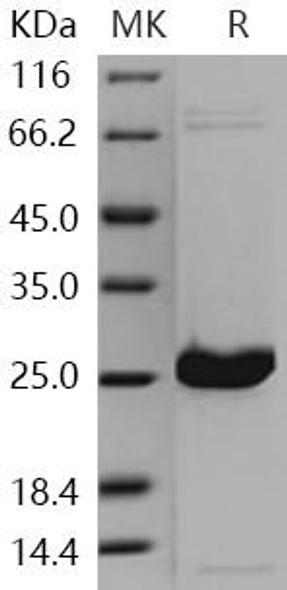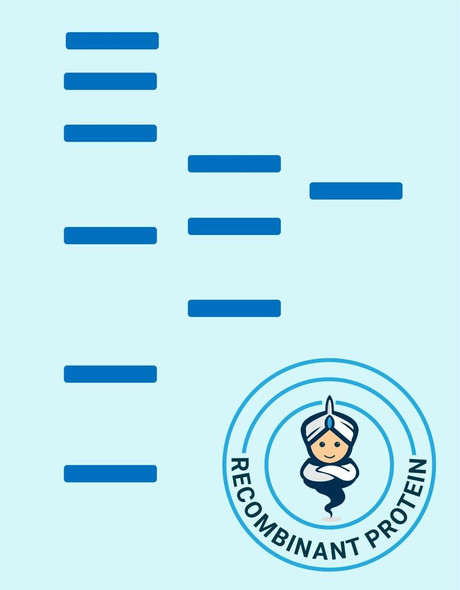Description
| Product Name: | Human UCHL1 Recombinant Protein |
| Product Code: | RPPB5074 |
| Size: | 25µg |
| Species: | Human |
| Target: | UCHL1 |
| Synonyms: | Ubiquitin carboxyl-terminal hydrolase isozyme L1, UCH-L1, EC 3.4.19.12, Ubiquitin thioesterase L1, Neuron cytoplasmic protein 9.5, PGP 9.5, UCHL1, PGP9.5, PARK5. |
| Source: | Escherichia Coli |
| Physical Appearance: | Sterile Filtered clear solution. |
| Formulation: | The UCHL1 protein solution (1mg/ml) contains 20mM Tris-HCl buffer (pH 8.0) and 2mM EDTA. |
| Stability: | Store at 4°C if entire vial will be used within 2-4 weeks. Store, frozen at -20°C for longer periods of time. For long term storage it is recommended to add a carrier protein (0.1% HSA or BSA).Avoid multiple freeze-thaw cycles. |
| Purity: | Greater than 95.0% as determined by SDS-PAGE. |
| Amino Acid Sequence: | MQLKPMEINP EMLNKVLSRL GVAGQWRFVD VLGLEEESLG SVPAPACALL LLFPLTAQHE NFRKKQIEEL KGQEVSPKVY FMKQTIGNSC GTIGLIHAVA NNQDKLGFED GSVLKQFLSE TEKMSPEDRA KCFEKNEAIQ AAHDAVAQEG QCRVDDKVNF HFILFNNVDG HLYELDGRMP FPVNHGASSE DTLLKDAAKV CREFTEREQG EVRFSAVALC KAA |
| Biological Activity: | Specific activity: >�150 pmole/min/ug. Measured by the hydrolysis of Ubiquitin-AMC at pH 8.0, at 37C. |
UCHL1 (PGP9.5) belongs to a gene family whose products hydrolyze small C-terminal adducts of ubiquitin to produce the ubiquitin monomer. Protein Gene Product (PGP9.5) is a neuron specific protein, structurally and immunologically distinct from neuron specific enolase. Human UCHL1 and UCHL3 have an extremely complicated knot structure for a protein, with five knot crossings. It is considered that the knot structure may increase a protein's resistance to degradation in the proteasome.The protein, which has a molecular weight of 27 kDa was first defined by high resolution two dimetional PAGE. Standard immunohistochemical techniques have demonstrated the presence of PGP9.5 in neurons and nerve fibers at all levels of the central and peripheral nervous system, in many neurodcrine cells, in segments of the renal tubules, in spermatogonia and leydig cells of the testis, in ova and in some cells of both the pregnant and non pregnant corpus luteum. A point mutation (I93M) in UCHL1 is implicated as the cause of Parkinson's disease in one kindred. On the other hand, a polymorphism (S18Y) in UCHL1 has been found to be associated with a reduced risk for Parkinson's disease. Furthermore, UCHL1 is associated with the Alzheimer's disease, and required for normal synaptic and cognitive function.
UCHL1 Human Recombinant produced in E.Coli is a single, non-glycosylated, polypeptide chain containing 223 amino acids (1-223 a.a.) and having a molecular mass of 24.8 kDa (molecular weight on SDS-PAGE will appear higher).
| UniProt Protein Function: | UCHL1: Ubiquitin-protein hydrolase involved both in the processing of ubiquitin precursors and of ubiquitinated proteins. This enzyme is a thiol protease that recognizes and hydrolyzes a peptide bond at the C-terminal glycine of ubiquitin. Also binds to free monoubiquitin and may prevent its degradation in lysosomes. The homodimer may have ATP-independent ubiquitin ligase activity. Monomer. Homodimer. Interacts with SNCA. Interacts with COPS5. Found in neuronal cell bodies and processes throughout the neocortex. Expressed in neurons and cells of the diffuse neuroendocrine system and their tumors. Weakly expressed in ovary. Down-regulated in brains from Parkinson disease and Alzheimer disease patients. Belongs to the peptidase C12 family. |
| UniProt Protein Details: | Protein type:Ubiquitin conjugating system; Cell development/differentiation; Ligase; Protease; EC 3.4.19.12 Chromosomal Location of Human Ortholog: 4p14 Cellular Component: nucleoplasm; endoplasmic reticulum membrane; cell soma; axon; cytoplasm; plasma membrane; cytosol Molecular Function:ubiquitin binding; omega peptidase activity; protein binding; cysteine-type endopeptidase activity; ubiquitin-specific protease activity; alpha-2A adrenergic receptor binding; ligase activity Biological Process: cell proliferation; proteasomal ubiquitin-dependent protein catabolic process; negative regulation of MAP kinase activity; axon transport of mitochondrion; protein deubiquitination; axon target recognition; eating behavior; neuromuscular process; muscle fiber development; sensory perception of pain; adult walking behavior Disease: Neurodegeneration With Optic Atrophy, Childhood-onset; Parkinson Disease 5, Autosomal Dominant |
| NCBI Summary: | The protein encoded by this gene belongs to the peptidase C12 family. This enzyme is a thiol protease that hydrolyzes a peptide bond at the C-terminal glycine of ubiquitin. This gene is specifically expressed in the neurons and in cells of the diffuse neuroendocrine system. Mutations in this gene may be associated with Parkinson disease.[provided by RefSeq, Sep 2009] |
| UniProt Code: | P09936 |
| NCBI GenInfo Identifier: | 136681 |
| NCBI Gene ID: | 7345 |
| NCBI Accession: | P09936.2 |
| UniProt Secondary Accession: | P09936,Q4W5K6, Q71UM0, |
| UniProt Related Accession: | P09936 |
| Molecular Weight: | 223 |
| NCBI Full Name: | Ubiquitin carboxyl-terminal hydrolase isozyme L1 |
| NCBI Synonym Full Names: | ubiquitin carboxyl-terminal esterase L1 (ubiquitin thiolesterase) |
| NCBI Official Symbol: | UCHL1�� |
| NCBI Official Synonym Symbols: | NDGOA; PARK5; PGP95; PGP9.5; Uch-L1; HEL-117; PGP 9.5�� |
| NCBI Protein Information: | ubiquitin carboxyl-terminal hydrolase isozyme L1; ubiquitin thioesterase L1; epididymis luminal protein 117; neuron cytoplasmic protein 9.5; ubiquitin C-terminal hydrolase |
| UniProt Protein Name: | Ubiquitin carboxyl-terminal hydrolase isozyme L1 |
| UniProt Synonym Protein Names: | Neuron cytoplasmic protein 9.5; PGP 9.5; PGP9.5; Ubiquitin thioesterase L1 |
| Protein Family: | Ubiquitin carboxyl-terminal hydrolase |
| UniProt Gene Name: | UCHL1�� |
| UniProt Entry Name: | UCHL1_HUMAN |









